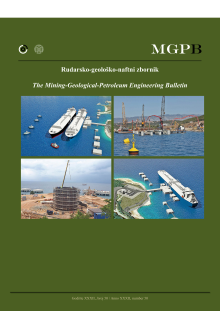Sulfur, metal(loid)s, radioactivity, and cytotoxicity in abandoned karstic Raša coal-mine discharges (the north Adriatic Sea)
DOI:
https://doi.org/10.17794/rgn.2020.3.1Keywords:
Raša coal-mine discharges, water, selenium, radioactivity, cytotoxicity, karstAbstract
Raša coal, mined on the Istrian Peninsula (NW Croatia) for nearly 400 years up to 1999, is notable for having superhigh organic sulfur, and high levels of selenium, uranium, vanadium, and molybdenum. Selenium is the poison responsible for the widespread loss of cattle and sheep. It is essential to human health in trace amounts, but higher concentrations can be harmful. An estimated 4.4Mt. of coal remains underground within marine carbonate rocks. The study area belongs to the coastal karst of the Adriatic Sea. Several abandoned coal-mine discharges (CMDs) were released into local streams and the Raša Bay for decades. Therefore, the water quality of a natural karst spring (Fonte Gaja), the Raša Bay seawater, municipal wastewater, and the Raša CMDs were investigated, focusing on sulfur, selected metal(loid)s (major, minor, and trace), radioactivity, and cytotoxicity. The Fonte Gaja spring water, unrelated to the Raša CMD, served as a reference. Its values of Se, U, V, and Mo (µg/L) were as follows: 1.09, 0.75, 1.37, and 2.04, respectively. However, the respective levels (µg/L) were increased in the rest of the water samples as follows: 10.9, 10.8, 4.60, and 33.1. Water sulfate levels were low though. Total beta activities of the CMDs and Raša Bay water were 235 and 1320 Bq/m3, respectively, below the guideline level of 2000 Bq/m3. The cytotoxicity of water samples on the RTG-2 fish cells was not statistically significant. The large volumes of water involved mean the transport of rather large amounts of Se and U, and their deposition in the Adriatic Sea. Due to the complexity of the karst hydrogeology, knowledge of Se and U circulation patterns is highly needed.
Downloads
Published
How to Cite
Issue
Section
License
Copyright (c) 2020 authors and journal

This work is licensed under a Creative Commons Attribution 4.0 International License.
Creative Commons-BY
Authors who publish with this journal agree to the following terms:
In agreeing this form, you certify that:
- You read the ethical codex of the RGN zbornik available at journal web.
- You submitted work is your original work, and has not previously been published and does not include any form of plagiarism.
- You own copyright in the submitted work, and are therefore permitted to assign the licence to publish to RGN zbornik.
- Your submitted work contains no violation of any existing copyright or other third party right or any material of an obscene, libellous or otherwise unlawful nature.
- You have obtained permission for and acknowledged the source of any illustrations, diagrams or other material included in the work of which you are not the copyright owner.
- You have taken due care to ensure the accuracy of the work, and that, to the best of your knowledge, there are no false statements made within it.
- All co-authors of this submitted work are aware of, and in agreement with, the terms of this licence and that the submitted manuscript has been approved by these authors.
Publication licence
You retain copyright in your submitted work, according to journal license policy (CC-BY). By signing this form you agree that RGN zbornik may publish it under the publication licence. In summary the licence allows the following:
Anyone is free:
- To copy, distribute, display, and perform the work.
- To make derivative works.
Under the following conditions:
- The original author must always be given credit.
- The work may not be used for commercial purposes.
- If the work is altered, transformed, or built upon, the resulting work may only be distributed under a licence identical to this one.
Exceptions to the licence
In addition to publishing the work printed under the above licence, RGN zbornik will also enable the work to be visible online.
The journal editorial can change the licence rules anytime but it cannot retroactively restrict author(s) rights.


